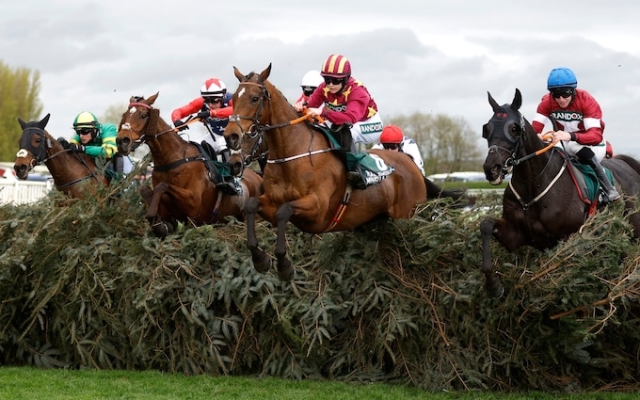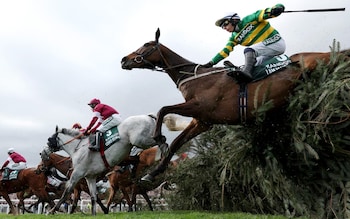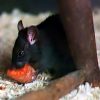 Runners and riders jump over the final fence at the Grand National on Saturday. Photo: PA/Nigel French
Runners and riders jump over the final fence at the Grand National on Saturday. Photo: PA/Nigel French
As is now traditional, Grand National Day began this year with the RSPCA backing the voluntary, woke and left-wing anti-race rhetoric the broadcast media had picked up on.
But even the RSPCA I would have to admit that this year's race is just the beginning. new era. However, are these changes the beginning of the end of a once great race or the beginning of a new optimistic future?
The positive thing is that the horses participating in the race were not injured, which everyone is very happy about. And it could be argued that any changes that take the wind out of the sails of intolerant and disproportionately powerful social media warriors are good for the survival of the race.
But those who shout the loudest on social media do not necessarily represent “the public.” , and the Grand National will not continue to be «the people's race» if the same dominant owners and trainers with a few runners vacuum it up every year.
No matter how great ambassadors sporting trainer Willie Mullins and owner JP McManus may be, it is a very dangerous path for competition to take when the data shows that a few can displace the rest by flooding the race with their own horses.
And this is not a criticism of the fact that most of the horses competing in Saturday's races were trained in Ireland. On the contrary, in the past, Irish winners have been the most colorful and interesting stories because they had a great passion for the sport.
As of this year, the horses in the class at the top of the handicap will now win every time because the risk and randomness of fences are generally eliminated.
I Maximus is not known as a great fence jumper. He made a mistake in the chair that in the past would have ruined his chances, and as Willie Mullins, his coach, pointed out, the way to win Nationals now is probably by cutting fences rather than big, extravagant jumps.
In another context it might be called a hurdle race, and if you look at the course for the second round on Saturday, it's not hard to see what Mullins is talking about. What was left of the fences was little more than a French-style obstacle.
Will the public still conduct office lotteries without danger?
The real danger to the Grand National now is that the public realizes that it looks and feels like a normal high handicap obstacle. Will they continue to hold raffles in the office and invite their friends to watch the race on TV?
I watched it on Saturday with a group of non-racing friends, and their reactions ranged from «it was a little unsatisfying» to «it wasn't exactly heroic.»
The other sad thing is… that these changes will affect what type of horses are bred. Who would want to breed big, sweeping, gorgeous riders if, as Mullins points out, bold jumps no longer win the Grand National? It is not an exaggeration to say that changes in the great race will have genetic consequences.
Making the Grand National more elitist will also change the general public's perception of their once-a-year awe. When the penny drops that the race is no longer a lottery giving everyone a chance, and the romantic sob stories dry up, the TV audience will begin to dwindle.
Aintree race organizers must also accept that no matter how many changes they make, The RSPCA will always be there to stab them in the back if anything goes wrong.
Their natural hatred is what they do. A misguided view of the sport of royalty is akin to the RSPB's hatred of people who maintain grouse moor habitat.
Life is inherently dangerous. Every time someone lets their cat out to kill some birds, it can get run over. But does the RSPCA condemn this behavior as irresponsible behavior leading to unnecessary suffering?
Of course not. As a political organization, they understand that alienating cat owners is not good business.
I had my doubts, but the Grand National tamer hasn't lost any of its magic
When the Grand National was first held in 1839, the fence in front of the stands was 4 feet 8 inches high. a stone wall, which was once jumped over, and a plow drove most of the route.
The following year, the wall was heavily criticized in the press because not only did the first winner, Lottery, fall on it, but it also knocked down three others, including the 3-1 favorite, Nun. Two years later it was replaced by an artificial water jump, not unlike today.
The water was considered too calm, so the Aintree boss reintroduced the wall — albeit to the dismay of owners and riders. That year he caused two terrible falls, and, in short, he was returned to diving, and gradually, field by field, the plow turned into turf, and step by step it became easier.
Thus, from the first year to 176, the Grand National was always evolving, but often reactively, several steps behind current tastes. But let's hope the changes at Aintree finally match what the public want to see.
I questioned the changes made after last year's disastrous race, which was affected by animal rights protests. It felt like we were giving in to people who would never be satisfied until the race was over, and I feared we had gone too far in pandering to them. I even called on the authorities to keep their composure and give the race another chance without protests.
But Saturday's national championship, the first in its history where we can confidently say that there was not a single loser, was easy and joyful. look, and yet for a player who comes along once a year, be it 40, 34 or 32 runners as there were on Saturday, that's still a lot of horses jumping big green fences over the long course in a historic race.
If you hadn't told everyone that the first fence had been moved 60 yards closer to the start most wouldn't have noticed, the standing start wasn't exactly standing but it was all right and for their part the jockeys turned their heads and made full use of the field width.
 Paul Townend on possible winner I Am Maximus jumping from his chair at Saturday's Grand National is the first project without failures. Photo: Getty Images/Michael Steele
Paul Townend on possible winner I Am Maximus jumping from his chair at Saturday's Grand National is the first project without failures. Photo: Getty Images/Michael Steele
I also think that holding the race earlier, at 4pm rather than at the end of a long day, was better for the horses, the competitors and the 60,000 spectators. If a few pounds less was wagered on the race, or a few pounds less was watched as a result, so what?
Without the debris and guts of the fences that were removed in 2012 to stop the tanks, it might not have been such a challenge for horses and jockeys as it once was, but with 15 runners still having a chance to cross Melling Road at the last time, it's amazing for the players and spectators. It may be a different race, but it is no lesser race. It's still the Grand National.
In three decades of reporting races for Telegraph Sport, some of the worst days have been when I switched off the lights in the Aintree press room, having to justify the race and the loss of life. Last year was one thing, 2012 was another, and I don’t want to do this any more than veterinarians on a course want to put all their knowledge into practice.
Of course there will be National Championships in the future when things don't go so smoothly and a horse gets injured, but yesterday, unlike a year ago, Instagram was full of happy horses back from Aintree having been turned out into the fields on a sunny day, rather than news from veterinary hospitals.
There is also a myth that there is always a great story associated with the winner, which is greatly exaggerated. There have been many cases over the years where this did not happen. Of course, this story would have been easier to write if Kitty's Light, who led last and then finished fifth behind I Am Maximus, had won, but the Willie Mullins-trained eight-year-old owned by JP McManus was still a great winner.
For many reasons, racing needed a good Saturday afternoon, and the magic of the National Championship was that it went above and beyond and provided it. This is sport talking and doing, not just talking.
As my 12-year-old daughter said after two days in Liverpool, but 24 hours before the start of the race: “I can’t wait until next year.”























































Свежие комментарии